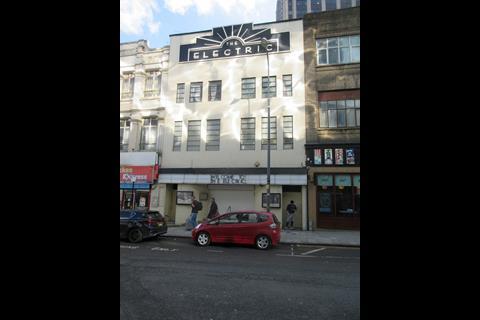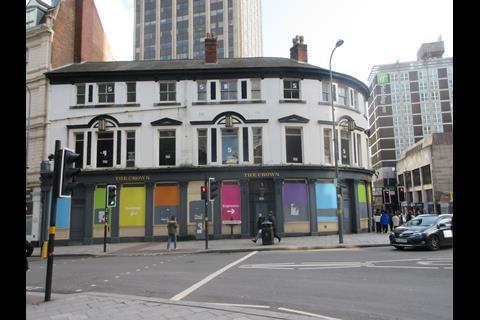The city’s disregard for its own heritage threatens one of the country’s oldest cinemas, a theatre once graced by Olivier, and the pub that hosted the first Black Sabbath gig, writes Joe Holyoak

The eastern part of Station Street in the centre of Birmingham ranks quite low in terms of its quality of place. It is a short street, and the northern side of it is the blank backside of New Street Station, punctuated by service entrances, with Foreign Office Architects’ reflective stainless steel cladding to the John Lewis store (now vacated) hanging over it. Station Street is a classic dingy back-of-the-railway-station location, but the remarkable opposite side of the street constitutes a small historic concentration of the city’s artistic culture.
It has just nine buildings, all of a consistent three- or four-storey scale. Among them are the Grade II listed Old Repertory Theatre, the Electric cinema, and the Crown pub. It is not in a conservation area, and the whole street block is now under threat of demolition and replacement by new residential development.
In addition to these three culturally significant buildings, there is another pub at the other end from the Crown, the 1883 orange brick and sandstone Market Hotel (both pubs were designed by Thomson Plevins). Next to it is the Comfort Inn hotel, and there is a snooker club, a massage parlour, some serviced apartments, and four restaurants (two Chinese, one Korean, one Japanese).
The Old Rep, designed by the architect S.N.Cooke, was the UK’s first purpose-built repertory theatre, opening in 1913. Its façade is an exercise in an austere Greek monumental-classic manner, with giant Ionic pilasters. The theatre was founded by Barry Jackson in 1911, and he continued to run it until 1948. Performing there at one time or another were Laurence Olivier, Peggy Ashcroft, Michael Gambon, Brian Cox and Ralph Richardson. In 1971 the theatre moved to its new building on Broad Street, designed by Graham Winteringham.
Curving around the junction of Station Street with Hill Street is Plevins’ stuccoed neo-classical Crown pub, built c1881. This is where Black Sabbath played their first gig and became regular performers, at the weekly Henry’s Blueshouse sessions upstairs, run by Jim Simpson, who then became their manager. Among the other bands making appearances at the club were Status Quo, Jethro Tull and Judas Priest. Led Zeppelin’s Robert Plant was a regular visitor, and jammed there with several different bands. The Crown has now been empty for a number of years. Its reopening as a music venue was promised in 2022, but fell through.
The Electric cinema has a claim to be the UK’s oldest working cinema. It opened in 1909. The cinema was originally converted that year from the ground floor and basement of a taxi garage. Its design was by Bertie Crewe (1860-1937), one of the leading theatre architects of the period. He was trained by Frank Matcham, and he also designed the Grade II listed Royal Court Theatre in London.
The cinema was rebuilt in 1937 in an Art Deco manner, designed by the local architect Cecil Fillmore (1901-1996). In 1980, it was bought by Lew Grade, and divided into two smaller auditoria. The Electric has metamorphosed through a remarkable sequence of identities through its long life. It has shown mainstream films, been a newsreel and cartoons cinema, become a place to see foreign arthouse films, and for a time somewhere to see soft pornography.
Its name has fluctuated in line with its identity. Starting as the Electric, it has been named the Tatler, the Select, the Jacey, the Classic, the Tivoli, and then the Electric again. Its various owners have included the entrepreneur Bill Heine, more famous for the Headington Shark on the roof of his house in Oxford. The 88-year lease signed by local entrepreneur Joseph Cohen in 1936 comes to an end in March 2024. At the beginning of March the Electric cinema shut its doors, to wide dismay.
The arts in Birmingham have an axe hanging over them, like much else in the city’s culture, because of the dire economic situation which the city now finds itself in. Following the issue of a Section 104 notice last September, effectively signalling the city’s bankruptcy because of disastrous past decisions, government commissioners are now taking all the important budgetary decisions in Birmingham.
So much of the small-scale street diversity in the centre of Birmingham has been lost by redevelopment
Major arts organisations, like Birmingham Royal Ballet and the City of Birmingham Symphony Orchestra, will lose over half of their previous funding this year, and next year there will be no funding at all. At the same time, the appetite for building highrise towers containing small apartments in the city centre seems to be insatiable. Birmingham’s planning culture is liberal and accommodating to new development, as it has been for decades, with short interruptions.
Its new tall buildings policy is more liberal than its predecessor, and numerous residential towers are springing up in response, frequently in unsuitable places, unrelated to their context. There is no three-dimensional spatial planning policy. Tall buildings, as I have noted in a previous column, are seen to convey prestige in Birmingham, irrespective of their design quality or their location.
In Station Street, the city’s fragile arts culture and the burgeoning market for city centre highrise flats are set to go head-to-head. As yet the nature of the likely development proposal is unspecified, but its existence is widely known. The block to the south side of Station Street is a microcosm of small-scale diversity, exemplifying Jane Jacobs’ observation about the need for aged buildings in order to generate diversity.
Orthodox modern town planning has not found a way to write and implement policies which generate diversity. New planned development invariably generates its opposite, uniformity. So much of the small-scale street diversity in the centre of Birmingham has been lost by redevelopment.
One small block in Station Street contains some remarkable buildings, and with them a huge amount of intangible 20th century history of enormous cultural value, which enriches peoples’ lives. If those in the city council considering planning decisions are unaware of Station Street’s significance, they must be made aware, and they must take steps to ensure that this valuable inheritance is not lost to expedient philistine property development.
> Also read: While Sheffield embraces its rich heritage, Birmingham once more shoots itself in the foot
Postscript
Joe Holyoak is an architect and urban designer practising in Birmingham




















2 Readers' comments